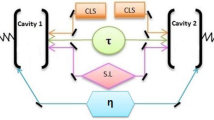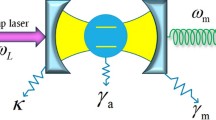Abstract
We investigate bipartite entanglement and quantum steering in a three-mode, hybrid electro-optomechanical system consisting of a Fabry–Perot optical cavity, a nanomechanical oscillator and a lumped-element microwave cavity. The nanomechanical resonator is directly coupled to the optical cavity on the one side via the moving mirror of the Fabry–Perot cavity, and on the other side, it is capacitively coupled to the microwave cavity. There is no direct coupling between the cavity modes. The optical cavity is blue-detuned through excitation by a laser source emitting short pulses, while the microwave cavity is red-detuned through excitation by a voltage pulse generator. The presence of bipartite entanglement between different modes is verified based on the asymmetric entanglement criteria. Specifically, the system is shown to behave effectively as a two-mode system in which a perfect bipartite EPR state can be formed by the optical cavity and the mirror. The possibility of generating genuine tripartite entanglement is also investigated by examining the necessary conditions for multiparty multimode entanglement. Simultaneous coupling of the three modes is shown to be possible in accordance with the genuine tripartite entanglement criteria. Furthermore, we establish the existence of quantum steering between the modes using the steering parameter formality and examine the monogamy relations to quantify the amount of bipartite steering shared between different modes. Notably, steering is found to be present only between the mechanical and the optical cavity modes.







Similar content being viewed by others
References
Gröblacher, S., Hammerer, K., Vanner, M.R., Aspelmeyer, M.: Observation of strong coupling between a micromechanical resonator and an optical cavity field. Nature 460, 724 (2009)
Genes, C., Mari, A., Vitali, D., Tombesi, P.: Quantum effects in optomechanical systems. Adv. At. Mol. Opt. Phys. 57, 33 (2009)
Aspelmeyer, M., Gröblacher, S., Hammerer, K., Kiesel, N.: Quantum optomechanics-throwing a glance. J. Opt. Soc. Am. B 27, 189 (2010)
Aspelmeyer, M., Kippenberg, T.J., Marquardt, F.: Cavity optomechanics. Rev. Mod. Phys. 86, 1391 (2014)
Muschik, C.A., Krauter, H., Hammerer, K., Polzik, E.S.: Quantum information at the interface of light with atomic ensembles and micromechanical oscillators. Quantum Inf. Process. 10, 839 (2011)
Mancini, S., Giovannetti, V., Vitali, D., Tombesi, P.: Entangling macroscopic oscillators exploiting radiation pressure. Phys. Rev. Lett. 88, 120401 (2002)
Ferreira, A., Guerreiro, A., Vedral, V.: Macroscopic thermal entanglement due to radiation pressure. Phys. Rev. Lett. 96, 060407 (2006)
Hartmann, M.J., Plenio, M.B.: Steady state entanglement in the mechanical vibrations of two dielectric membranes. Phys. Rev. Lett. 101, 200503 (2008)
Hammerer, K., Wallquist, M., Genes, C., Ludwig, M., Marquardt, F., Treutlein, P., Zoller, P., Ye, J., Kimble, H.J.: Strong coupling of a mechanical oscillator and a single atom. Phys. Rev. Lett. 103, 063005 (2009)
Paternostro, M., De Chiara, G., Palma, G.M.: Cold-atom-induced control of an optomechanical device. Phys. Rev. Lett. 104, 243602 (2010)
Camerer, S., Korppi, M., Jockel, A., Hunger, D., Hansch, T.W., Treutlein, P.: Realization of an optomechanical interface between ultracold atoms and a membrane. Phys. Rev. Lett. 107, 223001 (2011)
Huang, K., Yan, Y., Zhu, J., Xiao, Y., Li, G.: Non-classical non-Gaussian state of a mechanical resonator via selectively incoherent damping in three-mode optomechanical systems. Phys. Rev. A 93, 033832 (2016)
Sun, L.H., Li, G.X., Ficek, Z.: Coherence and entanglement in a nano-mechanical cavity. Phys. Rev. A 85, 022327 (2012)
Wang, Y.D., Clerk, A.A.: Reservoir-engineered entanglement in optomechanical systems. Phys. Rev. Lett. 110, 253601 (2013)
Barzanjeh, S., Vitali, D., Tombesi, P., Milburn, G.J.: Entangling optical and microwave cavity modes by means of a nanomechanical resonator. Phys. Rev. A 84, 042342 (2011)
Andrews, R.W., Peterson, R.W., Purdy, T.P., Cicak, K., Simmonds, R.W., Regal, C.A., Lehnert, K.W.: Bidirectional and efficient conversion between microwave and optical light. Nat. Phys. 10, 321 (2014)
Barzanjeh, S., Abdi, M., Milburn, G.J., Tombesi, P., Vitali, D.: Reversible optical-to-microwave quantum interface. Phys. Rev. Lett. 109, 130503 (2012)
Bagci, T., Simonsen, A., Schmid, S., Villanueva, L.G., Zeuthen, E., Appel, J., Taylor, J.M., Sørensen, A., Usami, K., Schliesser, A., Polzik, E.S.: Optical detection of radio waves through a nanomechanical transducer. Nature 507, 81 (2014)
Cernotik, O., Hammerer, K.: Measurement-induced long-distance entanglement of superconducting qubits using optomechanical transducers. Phys. Rev. A 94, 012340 (2016)
Bochmann, J., Vainsencher, A., Awschalom, D.D., Cleland, A.N.: Nanomechanical coupling between microwave and optical photons. Nat. Phys. 9, 712 (2013)
Hofer, S.G., Wieczorek, W., Aspelmeyer, M., Hammerer, K.: Quantum entanglement and teleportation in pulsed cavity optomechanics. Phys. Rev. A 84, 052327 (2011)
He, Q.Y., Ficek, Z.: Einstein–Podolsky–Rosen paradox and quantum steering in a three-mode optomechanical system. Phys. Rev. A 89, 022332 (2014)
Einstein, A., Podolsky, B., Rosen, N.: Can quantum-mechanical description of physical reality be considered complete? Phys. Rev. 47, 777 (1935)
Wang, Y.D., Chesi, S., Clerk, A.A.: Bipartite and tripartite output entanglement in three-mode optomechanical systems. Phys. Rev. A 91, 013807 (2015)
He, Q.Y., Reid, M.D.: Einstein–Podolsky–Rosen paradox and quantum steering in pulsed optomechanics. Phys. Rev. A 88, 052121 (2013)
Wang, M., Gong, Q.H., Ficek, Z., He, Q.Y.: Efficient scheme for perfect collective Einstein–Podolsky–Rosen steering. Sci. Rep. 5, 12346 (2015)
Eghbali-Arani, M., Ameri, V.: Entanglement of two hybrid optomechanical cavities composed of BEC atoms under Bell detection. Quantum Inf. Process. 16, 47 (2017)
Gebremariam, T., Mazaheri, M., Zeng, Y., Li, C.: Dynamical quantum steering in a pulsed hybrid opto-electro-mechanical system. J. Opt. Soc. Am. B 36, 168 (2019)
Simon, R.: Peres–Horodecki separability criterion for continuous variable systems. Phys. Rev. Lett. 84, 2726 (2000)
Teufel, J.D., Donner, T., Li, D., Harlow, J.W., Allman, M.S., Cicak, K., Sirois, A.J., Whittaker, J.D., Lehnert, K.W., Simmonds, R.W.: Sideband cooling of micromechanical motion to the quantum ground state. Nature 471, 204 (2011)
Vanner, M.R., Pikovski, I., Cole, G.D., Kim, M.S., Brukner, C., Hammerer, K., Milburn, G.J., Aspelmeyer, M.: Pulsed quantum optomechanics. Proc. Natl. Acad. Sci. 108, 16182 (2011)
Bowen, W.P., Milburn, G.J.: Quantum Opto-mechanics. CRC Press, Berlin (2016)
Walls, D.F., Milburn, G.J.: Quantum Optics. Springer, Berlin (1994)
Ghobadi, R., Kumar, S., Pepper, B., Bouwmeester, D., Lvovsky, A.I., Simon, C.: arXiv:1401.2356 [quant-ph]
Ghobadi, R., Kumar, S., Pepper, B., Bouwmeester, D., Lvovsky, A.I., Simon, C.: Opto-mechanical micro-macro entanglement. Phys. Rev. Lett. 112, 080503 (2014)
Weedbrook, C., Pirandola, S., Garcia-Patron, R., Cerf, N.J., Ralph, T.C., Shapiro, J.H., Lloyd, S.: Gaussian quantum information. Rev. Mod. Phys. 84, 621 (2012)
Duan, L.M., Giedke, G., Cirac, J.I., Zoller, P.: Inseparability criterion for continuous variable systems. Phys. Rev. Lett. 84, 2722 (2000)
Giovannetti, V., Mancini, S., Vitali, D., Tombesi, P.: Characterizing the entanglement of bipartite quantum systems. Phys. Rev. A 67, 022320 (2003)
He, Q.Y., Gong, Q.H., Reid, M.D.: Classifying directional gaussian entanglement, Einstein–Podolsky–Rosen steering, and discord. Phys. Rev. Lett. 114, 060402 (2015)
Riedinger, R., Wallucks, A., Marinkovi, I., Loschnauer, C., Aspelmeyer, M., Hong, S., Groblacher, S.: Remote quantum entanglement between two micromechanical oscillators. Nature 556, 473 (2018)
Teh, R.Y., Reid, M.D.: Criteria for genuine N-partite continuous-variable entanglement and Einstein–Podolsky–Rosen steering. Phys. Rev. A 90, 062337 (2014)
van Loock, P., Furusawa, A.: Detecting genuine multipartite continuous-variable entanglement. Phys. Rev. A 67, 052315 (2003)
Giedke, G., Kraus, B., Lewenstein, M., Cirac, J.I.: Separability properties of three-mode Gaussian states. Phys. Rev. A 64, 052303 (2001)
Li, J., Zhu, S.Y., Agarwal, G.S.: Magnon–Photon–Phonon entanglement in cavity magnomechanics. Phys. Rev. Lett. 121, 203601 (2018)
Schroedinger, S.: The present status of quantum mechanics. Naturwiss 23, 807 (1935)
Schroedinger, S.: Discussion of probability relations between separated systems. Proc. Camb. Philos. Soc. 31, 555 (1935)
Schroedinger, S.: Probability relations between separated systems. Proc. Camb. Philos. Soc. 32, 446 (1936)
Reid, M.D.: Demonstration of the Einstein–Podolsky–Rosen paradox using nondegenerate parametric amplification. Phys. Rev. A 40, 913 (1989)
Wiseman, H.M., Jones, S.J., Doherty, A.C.: Steering, Entanglement, nonlocality, and the Einstein–Podolsky–Rosen paradox. Phys. Rev. Lett. 98, 140402 (2007)
Cavalcanti, E.G., Jones, S.J., Wiseman, H.M., Reid, M.D.: Experimental criteria for steering and the Einstein–Podolsky–Rosen paradox. Phys. Rev. A 80, 032112 (2009)
Kiesewetter, S., He, Q.Y., Drummond, P.D., Reid, M.D.: Scalable quantum simulation of pulsed entanglement and Einstein–Podolsky–Rosen steering in optomechanics. Phys. Rev. A 90, 043805 (2014)
Genes, C., Mari, A., Tombesi, P., Vitali, D.: Robust entanglement of a micromechanical resonator with output optical fields. Phys. Rev. A 78, 032316 (2008)
Hndchen, V., Eberle, T., Steinlechner, S., Samblowski, A., Franz, T., Werner, R.F., Schnabel, R.: Observation of one-way Einstein–Podolsky–Rosen steering. Nat. Photonics 6, 598 (2012)
Wagner, K., Janousek, J., Armstrong, S., Morizur, J.F., Lam, P.K., Bachor, H.A.: Mixed state entanglement and quantum error correction. Phys. Rev. A 54, 3824 (1996)
Acknowledgements
The authors would like to thank Z. Jalali-Mola for valuable discussions.
Author information
Authors and Affiliations
Corresponding author
Additional information
Publisher's Note
Springer Nature remains neutral with regard to jurisdictional claims in published maps and institutional affiliations.
Appendix A
Appendix A
Taking the input noise correlations into account, the expressions for the covariance matrix elements are given herein as a function of the normalized interaction time parameter r, parameters \(\alpha \) and \(\beta \) (defined in the main text), the scaled damping parameter \(\gamma \), the mean number of thermal phonons, \(n_{m}\), and the equilibrium number of photons, \(n_{a}\) and \(n_{b}\), in the optical and microwave cavities, respectively. Expressly, the elements of the covariance matrix can be written in the explicit form as
and
Rights and permissions
About this article
Cite this article
Mazaheri, M., Jamasb, S. Pulsed entanglement and quantum steering in a three-mode electro-optomechanical system. Quantum Inf Process 19, 222 (2020). https://doi.org/10.1007/s11128-020-02721-6
Received:
Accepted:
Published:
DOI: https://doi.org/10.1007/s11128-020-02721-6




